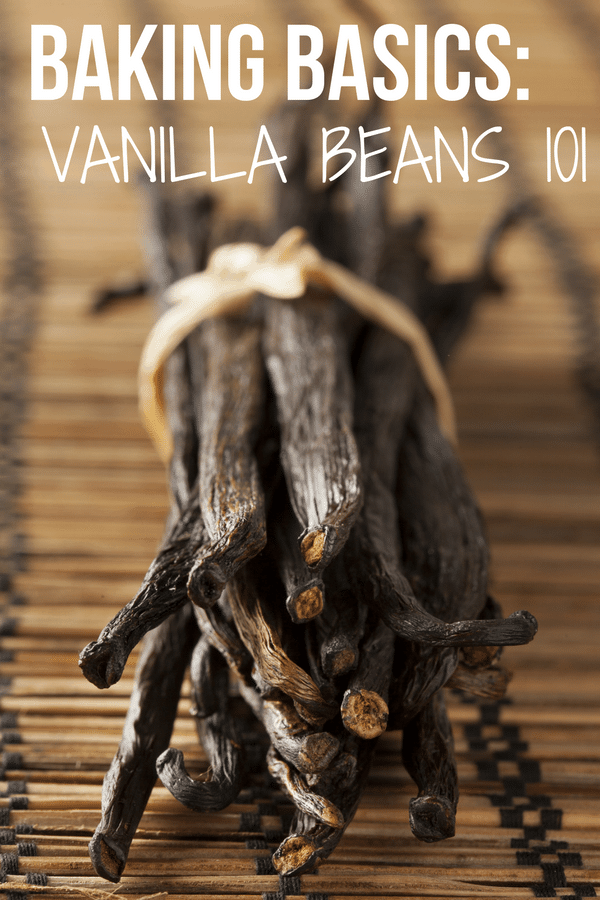Baking Basics: Vanilla Beans 101
It’s another Baking Basics Tuesday!
Today we’re talking about one of my very favorite ingredients – vanilla beans! Most people that bake even occasionally keeps a bottle of vanilla extract in their pantry, but where did that come from? Vanilla beans!
There are a number of different varieties of vanilla beans, so today we’re going to explore all of the differences, and when it’s best to use each one. I’m also including information on where I like to buy mine, how best to store them and an easy formula for making your own vanilla extract.
Let’s jump in!
Types of Vanilla Beans
- Madagascar (Bourbon) Vanilla Beans – These vanilla beans are grown in Madagascar and the West Indian island of Réunion. (Réunion was previously called the island of Bourbon, which is where this vanilla got its common name from.) This is the most typical type of vanilla and has a strong, sweet, rich and creamy flavors. This vanilla is best used in baked goods where the flavor is meant to complement, not dominate, the dish, which is most baked goods. This is the type of vanilla extract and vanilla bean paste that I keep in my pantry.
- Mexican Vanilla Beans – These (unsurprisingly) originated from Mexico, and the vanilla pods that are thicker than other varieties. This variety is dark, bold, smokey, and richer than Madagascar vanilla and has a robust fragrance. It’s best used in recipes where vanilla is meant to play a starring role.
- Tahitian Vanilla Beans – floral, cherry-chocolate Tahitian vanilla comes from the French Polynesian island of Tahiti. It has less natural vanillin (that distinctive vanilla taste) than Bourbon and Mexican vanilla. This variety has a more sweet, fruity, cherry-chocolate, floral, licorice taste. The Tahitian vanilla pod is fatter than Bourbon vanilla, and contains fewer seeds inside the pod. Its unique taste make it a great choice for dishes that use vanilla as its main flavor profile.
- Indian Vanilla Beans – Indian vanilla beans are less common than Madagascar Bourbon, Mexican and Tahitian vanilla; the flavor is sweet, creamy and extremely aromatic. Indian Vanilla Beans can be used in most of the same recipes where Madagascar Bourbon vanilla beans are used.
- Tonga Vanilla Beans – Tonga Vanilla Beans come from The Kingdom of Tonga which is made up of several island groups in the South Pacific. Because of Tonga’s rich fertile soil, beans from this region are superior, with an extremely bold flavor and aroma. Tonga vanilla beans are frequently used by gourmet chocolate makers because the of the bold, pronounced flavor.
Where to Buy Vanilla Beans
My very favorite place to buy vanilla beans is from Beanilla, but you can also find tons of varieties on Amazon.
How to Store Vanilla Beans
The absolute worst thing is going to get your (very expensive) vanilla beans from the pantry and finding that they have dried out. THE WORST. So how can you keep them as fresh as possible?
Simply wrap the vanilla beans (you can wrap them as a bundle, you don’t need to wrap them individually) tightly in plastic wrap and store in an airtight container. Store them in a cool, dark place like your pantry.
How to Make Your Own Homemade Vanilla Extract
It’s so easy! Plus, homemade vanilla extract is perfect for handing out at the holidays. If that’s your plan, get your beans and alcohol and get started soon!
Ideal Beans to Alcohol Ratio: 5 vanilla beans per 8 ounces of alcohol
Ideal Alcohol to Use: Vodka is the most common alcohol used in making vanilla extract, but you can totally play around with different liquors to impart different flavors. Other popular options are bourbon and brandy.
How to Do It: Using a paring knife, slit the vanilla beans lengthwise and drop them into the bottle of alcohol. Give it a little shake and then store it in a cool, dark place (pantry or basement) for about 2 months, shaking occasionally. You can leave the vanilla beans in the bottle as you use it, but they need to stay submerged, so you’ll need to top it off with more alcohol as you use the extract.
BAKE ON!
Check out more posts in the Baking Basics series:
5 Mistakes to Avoid When Preparing a Recipe
Flour 101: The Definitive Guide to the Different Types of Baking Flours
Cocoa Powder 101: Natural Unsweetened vs Dutch-Process
Baking Soda vs. Baking Powder: Everything You Need to Know!
Why You Should ALWAYS Weigh Your Ingredients






Dried out beans are NOT the worst.
Completely dry them and make into vanilla powder using a coffee mill. Excellent!
I have gotten vanilla beans from Olive Nation several times.
Great info! I buy my vanilla beans from Arizona Vanilla & think their service & products are great. I buy the lower grade beans & add LOTS to a bottle of vodka.
I keep a constant bottle of vanilla brewing all the time. I just add more vodka as it gets low and more beans as I use them in other recipes. My favorite source is Indri Vanilla at http://www.indrivanilla.com
I love using vanilla beans!
So even though Tahitian has less vanillin, I should still use it when I want the vanilla to serve as a main component (eg, vanilla ice cream. which I LOVE)?
Yes, you absolutely can!
Aaah, sweet and succulent vanilla. Next to lilacs, is there really any better aroma in the world? Hmm… well, on second thought, bacon frying and sesame oil come to mind. But still, vanilla is pure heaven in both taste and scent. Excellent article there, BEB!
Awesome article about vanilla. I never realized that there were vanilla beans from India.
I read some years back a tip to always double or triple the amount of vanilla in a recipe. I do that to this day. There can’t be too much vanilla as far as I am concerned, as long as it is pure extract and high quality.
Also, I take used beans and put them in my sugar dispenser to give the sugar some vanilla essence.
Again, this was a really interesting read. Thanks for the article.
I have a bottle of vanilla that I started the beginning of May, so it’s been brewing for 3 months now and should be ready to use. However, I used only 1 bean for the 12 oz bottle. According to your recipe I should have used 7 or 8 beans! Do you think my vanilla will be way too weak? I’m guessing it will be. If it makes any difference, I used vodka and I’m guessing the bean would be either Mexican, Madagascar or Indian, but really can’t be sure.
Hi Michelle, I do think 1 bean for a 12-ounce bottle will not be enough, but you could just add more now and let it brew longer!
I also use vanilla bean paste as my go-to vanilla, but when I want to make the vanilla flavor shine, I love to mix several different vanillas. I find a white cake made with multiple varieties of vanilla is so much more interesting than just a plain vanilla cake. And I love to sub Mexican vanilla in things like brownies, or Tahitian in pancake or waffle batter. People can never figure out why it tastes just a little different, but better, than what they are used to.
After ABC did the story on Mexican vanilla containing coumarin – which can damage your liver – I stopped buying it. You might want to read up on this.
This was super interesting, Michelle. I’ve come to use Vanilla bean paste for almost everything ( I plow through an embarrassing amount) but I’m excited to check out the different varieties.